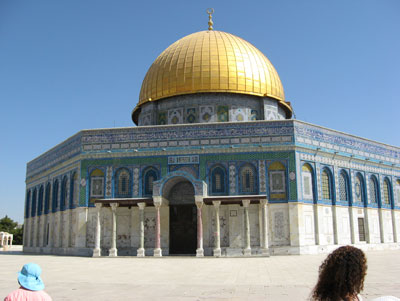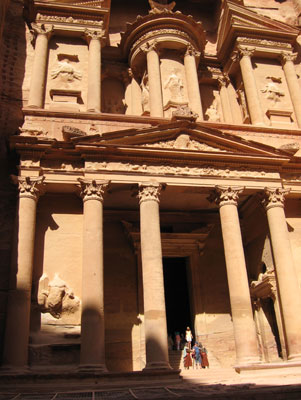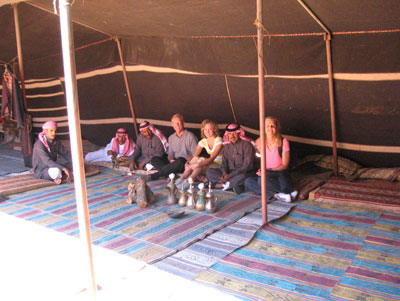Exploring holy and historical sites in Israel and Jordan
by Ashley Mannion, Fountain Hills, AZ
My family and I decided to take an “adventure vacation” in summer ’08 to an area where none of us had been before. Our neighbors had taken a trip to Jordan and raved about how great everything went for them. Neighboring Israel had always been on our list of interesting places to visit, although we continued to have safety concerns. Nevertheless, on June 6 we began our journey to experience the Holy Land.
Beginning in Jordan
Jordan is a fascinating country, filled with history. On our 7-day private tour, we had two very informative guides. We saw many ruins and historical sites in Jerash, Amman and Kerak and visited Mt. Nebo and Petra, the latter being one of the New Seven Wonders of the World.
Petra is an amazingly beautiful hidden city. We began our visit with a horseback ride through part of the winding canyon passageway that leads to the ruin/city of Petra. We spent the whole day exploring the area, which was much larger than any of us had expected. We walked for hours looking at the numerous caves, artifacts and buildings that were constructed so many thousands of years ago.
Before crossing the border from Jordan into Israel, we took an expedition into the desert of Wadi Rum. We rode through the sand dunes and took a camel ride to see the many petroglyphs that had been carved into the rocks long ago. My family and I were also welcomed into a Bedouin tent, where we were served mint tea and dressed up in the traditional garb of Jordanian men and women.
Crossing into Israel
The distance between Jordan and Israel is minimal, so we had decided it would take less time to cross the mile-long bridge into Israel than spend a day traveling by plane and passing through airport security.
On the road out of Jordan there were about five checkpoints where our passports were checked. Our Jordanian guide was not allowed to take us across the first gate on the bridge, so we left our tour guide and jumped into a taxi (driven by a Jordanian) to the next checkpoint, less than one minute away from the initial gate. There our luggage was scanned and searched.
After passing inspection, we hopped back into the taxi to ride to the next checkpoint, another half minute away. At this station we received our Jordanian exit visas and waited for the bus that runs about every half hour into Israel.
After a short 2-minute ride, we crossed into Israel territory. Once we reached the border, we were greeted by the Israeli military sitting in tanks with large machine guns. Our luggage was once again searched and inspected before we received our passport stamps to enter the country.
After passing through Israeli Customs and Immigration, we were welcomed by our next tour guide.
Religious sightseeing
While in Israel, we wanted to see and experience the cultural aspects of the country. Being Christian, we were interested in the religious importance of various sites and we visited many, including churches, tombs and areas where miracles had been performed.
Much to my surprise, several of the places I would consider “sacred” were part of everyday life there. For example, the Sea of Galilee serves as a recreational body of water for jet-skiing and boating, and several side streets along the Way of the Cross are used for a bazaar.
Jerusalem is a beautiful, old city. We visited the Dome of the Rock, touched the Wailing Wall and walked the Way of the Cross (Via Dolorosa). While walking this winding street, we were able to find each of the locations where Jesus had struggled, marking the Stations of the Cross.
Finally, we came to the place where the Church of the Holy Sepulchre was built around the site where it is said Jesus was crucified and buried before His resurrection.
We also visited Mt. Zion, with King David’s Tomb and the Place of the Last Supper.
Next we traveled into the city of Bethlehem, which is currently under Palestinian rule. After a short city tour, we visited the Church of the Nativity, which marks the location where Mary gave birth to Jesus.
We then traveled back into Israel for a visit to the Dead Sea. On our way we viewed from the road the cave where the Dead Sea Scrolls were discovered.
The Dead Sea was a lovely place to relax and float. We also were given the opportunity to experience one of the many famous Dead Sea products: the mud. I took a mud bath, covering my body with the clay-like mud that is reported to help cleanse your pores and make your skin and hair smooth and soft to the touch.
After a few days we made the return trip across the bridge into Jordan. Once we arrived on the other side, we were happily welcomed by our original Jordanian guide. The next day, we were sad to say good-bye to this wonderful country.
Planning a trip
During this trip, all of us felt extremely safe at all times. Our tour guides made a world of difference in the amount of information that was provided to us. The food and accommodations were always a pleasure and exceeded all of our expectations.
The beauty of every place visited was marvelous and I encourage anyone interested to go to Jordan and Israel to experience what my family and I did.
The tour company we used was Dakkak Travel (Dallas, TX; 800/256-6577, www.dtatravel.com). The land price for our 10-day tour, including private guides, ground transportation, 4-star hotels, breakfasts and dinners, was $3,284 per person. International airfare was an additional $1,440 per person, round trip from New York to Amman.
Conservative dress covering knees and shoulders was appropriate, and, for women, a scarf was occasionally needed at some religious sights.
The political situation in the Middle East should be evaluated before any trip, as conditions do change.
This adventure, like many others I have been fortunate to experience, was an eye-opener for me. Seeing the lives of other people around the world is educating, and it was simply amazing to be at the core of so many historical, religious and cultural places that I had heard about since I was young.
Travel allows us to see the viewpoints of others from all over the world and to understand that everyone aspires to the same objectives in life. No matter where they live or what their race or religion, everyone wants to have a happy, peaceful life.




